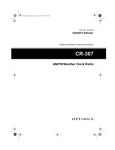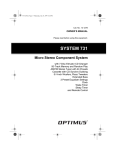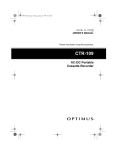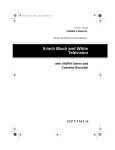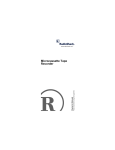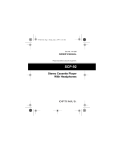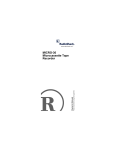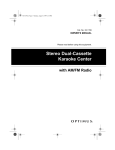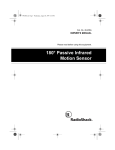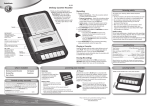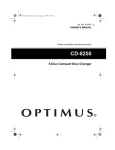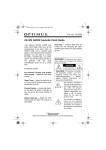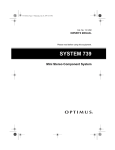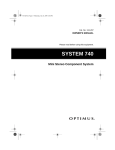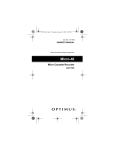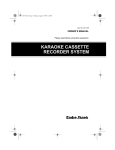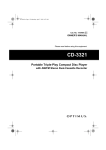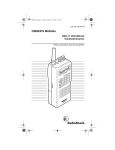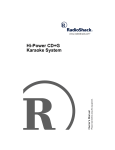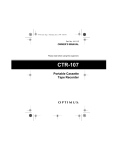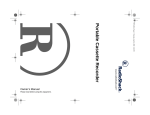Download Optimus CTR-108 User's Manual
Transcript
14-1115.fm Page 1 Friday, January 8, 1999 10:31 AM
Cat. No. 14-1115 A
OWNER’S MANUAL
Please read before using this equipment.
CTR-108
AC•DC Portable
Cassette Recorder
14-1115.fm Page 2 Friday, January 8, 1999 10:31 AM
FEATURES
Your Optimus CTR-108 AC•DC Portable Cassette Recorder is a multi-function recorder. Easy to use and reliable,
it is ideal for both personal and business use. Its features include:
Automatic Stop — protects the tape
and tape handling parts by automatically stopping the tape when it reaches
the end.
Built-In Condenser Microphone —
gives you high sensitivity for recording
speakers from several feet away, such
as at conferences.
Supplied Earphone — lets you listen
to the recorder without disturbing others.
Built-In Carrying Handle — lets you
easily carry the cassette recorder anywhere you go.
Supplied Erase Plug — makes erasing a cassette tape easy.
Warning: To prevent fire or shock
hazard, do not expose this product
to rain or moisture.
MIC Jack — lets you connect an optional external microphone to record
from longer distances.
Automatic Level Control (ALC) Circuit — automatically ensures the
proper recording level.
Record Indicator — lights steadily to
confirm you are recording.
CAUTION
RISK OF ELECTRIC SHOCK.
DO NOT OPEN.
CAUTION: TO REDUCE THE RISK OF
ELECTRIC SHOCK, DO NOT REMOVE
COVER OR BACK. NO USER-SERVICEABLE PARTS INSIDE. REFER SERVICING TO QUALIFIED PERSONNEL.
This symbol is intended to alert you
to the presence of uninsulated dangerous voltage within the system’s
enclosure that might be of sufficient
magnitude to constitute a risk of electric shock. Do not open the system’s
case.
Three Power Sources — let you power the recorder from four C batteries,
standard AC power (with the supplied
power cord), or vehicle DC power (with
an optional DC adapter).
AUX Jack — lets you connect an external sound source so you can record
directly from it.
!
This symbol is intended to inform you
that important operating and maintenance instructions are included in the
literature accompanying this system.
© 1997, 1999 Tandy Corporation.
All Rights Reserved.
Optimus and RadioShack are registered trademarks used by Tandy Corporation.
2
!
14-1115.fm Page 3 Friday, January 8, 1999 10:31 AM
CONTENTS
Preparation............................................................................................................. 4
Connecting Power ............................................................................................. 4
Using Internal Batteries .............................................................................. 4
Using AC Power.......................................................................................... 5
Using Vehicle Battery Power....................................................................... 5
Using an Earphone ........................................................................................... 6
Listening Safely .......................................................................................... 6
Traffic Safety ............................................................................................... 6
Operation................................................................................................................ 7
Loading a Cassette Tape .................................................................................. 7
Playing a Cassette Tape.................................................................................... 7
Recording.......................................................................................................... 8
Using the Built-In Microphone .................................................................... 8
Using an External Microphone ................................................................... 8
Recording from a Connected Audio Source ............................................... 9
Tape Tips......................................................................................................... 10
Recommended Tapes............................................................................... 10
Erasing a Cassette Tape........................................................................... 10
Preventing Accidental Erasure ................................................................. 10
Restoring Tape Tension and Sound Quality.............................................. 11
Maintenance......................................................................................................... 12
Cleaning the Tape-Handling Parts .................................................................. 13
Specifications ...................................................................................................... 14
3
14-1115.fm Page 4 Friday, January 8, 1999 10:31 AM
PREPARATION
CONNECTING POWER
You can power the CTR-108 from any
of three power sources:
• Internal batteries
• Standard AC power (with the supplied power cord)
• Your vehicle’s cigarette-lighter
socket (with an optional DC
adapter)
Note: Connecting an AC power cord or
a DC adapter disconnects the internal
batteries.
Using Internal Batteries
You can power the CTR-108 from four
C batteries (not supplied). For the best
performance, we recommend alkaline
batteries, such as RadioShack Cat.
No. 23-551/651.
{
|
|
{
{
|
|
{
1. Press down on the battery compartment cover and slide it off in
the direction of the arrow.
4
2. Install the batteries as indicated
by the polarity symbols (+ and –)
marked inside the compartment.
Cautions:
• Use only fresh batteries of the
required size and recommended type.
• Do not mix old and new batteries, different types of batteries
(standard, alkaline, or rechargeable), or rechargeable
batteries of different capacities.
3. Replace the cover.
When the RECORD indicator becomes dim, replace the batteries.
Cautions:
• Always dispose of old batteries
promptly and properly.
• Never leave dead, old, or weak
batteries in the CTR-108. They
can leak chemicals and corrode or
damage electronic circuits.
• If you do not plan to use the CTR108 for a week or more, or if you
plan to use an adapter only,
remove the batteries to protect the
CTR-108 from possible battery
leakage.
14-1115.fm Page 5 Friday, January 8, 1999 10:31 AM
Using AC Power
To power the CTR-108 from standard
AC power, plug the supplied power
cord into the AC IN jack on the side of
the CTR-108. Then plug the other end
into a standard AC outlet.
OP
TIM
US
CTR-
108
AC/DCCASSET
/BATT TE RE
ERY CORD
ER
Cautions:
• Always plug the power cord into
the AC IN jack before you plug it
into the AC outlet, and always
unplug the power cord from the
AC outlet before you unplug it
from the AC IN jack.
Cautions:
• You must use a DC adapter that
supplies 6 volts and delivers at
least 300 milliamps. Its center tip
must be set to negative, and its
plug must correctly fit the CTR108’s DC IN 6V jack. The recommended adapter meets these
specifications. Using an adapter
that does not could damage the
CTR-108 or the adapter.
• Always plug the adapter into the
CTR-108 before you plug it into
the cigarette-lighter socket, and
always unplug the adapter from
the cigarette-lighter socket before
you unplug it from the CTR-108.
DC IN 6V
AUX
EAR
REM
MIC
VOLUME
• The power cord has a polarized
plug that is designed to fit into the
recorder’s jack only one way. If the
plug does not easily fit into the
jack, do not force it. Simply turn it
over and try again.
Using Vehicle Battery Power
You can power the CTR-108 from your
vehicle’s cigarette-lighter socket using
a DC adapter, such as Cat. No. 2731802 (not supplied).
1. Set the DC adapter’s voltage
switch to 6V.
2. Insert the adapter’s barrel plug
into the CTR-108’s DC IN 6V jack.
3. Insert the adapter’s larger plug
into the vehicle’s cigarette-lighter
socket.
5
14-1115.fm Page 6 Friday, January 8, 1999 10:31 AM
USING AN EARPHONE
Traffic Safety
For private listening, insert the supplied earphone’s 1/8-inch plug into the
EAR jack.
Do not wear an earphone while operating a motor vehicle or riding a bicycle.
This can create a traffic hazard and
can be illegal in some areas.
DC IN 6V
AUX
EAR
REM
MIC
VOLUME
Even though some earphones let you
hear some outside sounds when listening at normal volume levels, they
still can present a traffic hazard.
Note: Connecting the earphone automatically disconnects the built-in
speaker.
Listening Safely
To protect your hearing, follow these
guidelines when you use the earphone.
• Set the volume to the lowest setting before you begin listening.
After you begin listening, adjust
the volume to a comfortable level.
• Do not listen at extremely high volume levels. Extended high volume
listening can lead to permanent
hearing loss.
• Once you set the volume, do not
increase it. Over time, your ears
adapt to the volume level, so a volume level that does not cause discomfort might still damage your
hearing.
6
14-1115.fm Page 7 Friday, January 8, 1999 10:31 AM
OPERATION
LOADING A CASSETTE
TAPE
1. Take up any slack in the tape by
turning one of the cassette’s hubs
with a pencil.
PLAYING A CASSETTE
TAPE
1. Load the cassette tape.
2. Press PLAY. The cassette plays
until it reaches the end of the side,
then it automatically stops.
MIC
RECO
RD
PLAY
Caution: If you do not remove the
excess slack, the tape could
become tangled in the record/
playback mechanism.
2. Press STOP/EJECT to open the
cassette compartment door.
MIC
RECO
RD
PLAY
REWIND
FAST-F
STOP
EJECT
PAUSE
REWIND
FAST-F
STOP
EJECT
PAUSE
Notes:
• Press PAUSE to temporarily
stop playback. Press PAUSE
again to resume playback.
• To rapidly wind the tape forward
or backward, press STOP/
EJECT, then FAST-F or REWIND.
Press PLAY to resume playback.
3. Adjust VOLUME as desired.
REM
MIC
VOLUME
3. Load the cassette in the slot in the
door with its open edge out, the
side you want to play facing up,
and its full reel to the left.
4. Press STOP/EJECT to completely
stop playback before it automatically stops. Press STOP/EJECT
again to open the cassette compartment and remove the cassette
tape.
4. Close the door.
7
14-1115.fm Page 8 Friday, January 8, 1999 10:31 AM
RECORDING
4. Speak into MIC.
Notes:
MIC
• Before you load a cassette tape
for recording, be sure its eraseprotection tabs are in place (see
“Preventing Accidental Erasure”
on Page 10).
• The recorder’s Automatic Level
Control (ALC) circuit automatically
adjusts the recording level. VOLUME has no effect on recording.
Using the Built-In Microphone
1. Load a blank cassette tape, or one
you want to record over, into the
cassette compartment.
2. Place the CTR-108 2 to 3 feet
from the recording source.
3. Press RECORD to begin recording. Both PLAY and RECORD lock
down.
MIC
RECO
RD
PLAY
REWIND
FAST-F
STOP
EJECT
PAUSE
RECO
RD
PLAY
REWIND
FAST-F
STOP
EJECT
PAUSE
5. Press STOP/EJECT to stop recording.
Using an External
Microphone
You can connect an external microphone (not supplied) with a 1/8-inch
plug to the CTR-108. Your local
RadioShack store sells a variety of microphones.
Note: Connecting an external microphone automatically disconnects the
built-in microphone.
Follow these steps to record using an
external microphone.
1. Load a blank cassette tape, or one
you want to record over, into the
cassette compartment.
2. Insert the microphone’s plug into
the CTR-108’s MIC jack.
Note: To temporarily stop recording, press PAUSE. Press PAUSE
again to resume recording.
8
DC IN 6V
AUX
EAR
REM
MIC
VOLUME
14-1115.fm Page 9 Friday, January 8, 1999 10:31 AM
Note: If the external microphone
has a separate, smaller plug for
remote operation, insert that plug
into the REM jack. Then you can
use the microphone’s remote
switch to stop or start recording.
3. Press RECORD to begin recording. Both PLAY and RECORD lock
down.
Note: If you connected an external microphone, disconnect it.
1. Load a blank cassette tape, or one
you want to record over, into the
cassette compartment.
2. Connect the external source to the
AUX jack.
DC IN 6V
Note: To temporarily stop recording, press PAUSE. Press PAUSE
again to resume recording.
4. Speak into the external microphone.
5. Press STOP/EJECT to stop recording.
Recording from a Connected
Audio Source
You can record directly from an external audio source, such as a radio, tape
deck, or CD player. To make the connection, you need a suitable mono
patch cord with a 1/8-inch plug (available from your local RadioShack
store).
Note: Before you connect an external
audio source to the recorder, be sure
the source’s and the recorder’s volume
controls are set to their minimum settings.
AUX
EAR
REM
MIC
VOLUME
External
source
3. Start the external audio source
and set its volume control to a normal listening level.
4. Press RECORD to begin recording. Both PLAY and RECORD lock
down.
Note: To temporarily stop recording, press PAUSE. To resume
recording, press PAUSE again.
5. Press STOP/EJECT to stop recording. Then stop the audio source.
Note: During recording, the speaker is
muted. If you want to monitor the recording, use the supplied earphone.
Follow these steps to record from an
external audio source.
9
14-1115.fm Page 10 Friday, January 8, 1999 10:31 AM
TAPE TIPS
Preventing Accidental
Erasure
Recommended Tapes
Tape quality greatly affects the quality
of the recording. We recommend extended-range or low noise Type 1 regular length (60- or 90-minute) normalbias cassette tapes. We do not recommend long-play cassette tapes such as
C-120s because they are thin and can
easily tangle.
Erasing a Cassette Tape
To record over a cassette tape, simply
record as usual. The cassette deck
records over the previous recording.
To erase the entire cassette tape, insert the supplied erasing plug into the
MIC jack and press RECORD. (Be sure
you have not connected anything to
the AUX jack.)
DC IN 6V
AUX
EAR
REM
MIC
VOLUME
If you need to erase an entire cassette,
you might prefer using a bulk tape
eraser, available at your local
RadioShack store.
Cassette tapes have two erase-protection tabs — one for each side. When a
tab is in place, you can record on that
side.
To protect a recording from being accidentally recorded over or erased, use
a screwdriver to remove one or both of
the cassette tape’s erase-protection
tabs. This prevents RECORD from being pressed.
Side A Tab
A
If you later decide to record on a tape
side after you have removed its eraseprotection tab, place a piece of strong
plastic tape over that side’s erase-protection hole. Be sure you cover only
the hole originally covered by the
erase-protection tab.
A
Caution: Removing the erase-protection tabs does not prevent a bulk eraser from erasing a cassette tape.
10
14-1115.fm Page 11 Friday, January 8, 1999 10:31 AM
Restoring Tape Tension and
Sound Quality
After you play a cassette tape several
times, the tape might become tightly
wound on the reels. This can cause
playback sound quality to deteriorate.
To restore the sound quality, fastforward the tape from the beginning to
the end of one side, then completely
rewind it. Then loosen the tape reels
by gently tapping each side of the cassette’s outer shell on a flat surface.
Caution: Be careful not to damage the
cassette when tapping it. Do not touch
the exposed tape or allow any sharp
objects near the cassette.
11
14-1115.fm Page 12 Friday, January 8, 1999 10:31 AM
MAINTENANCE
Your RadioShack CTR-108 AC•DC Portable Cassette Recorder is an example of
superior design and craftsmanship. The following suggestions will help you care for
your CTR-108 so you can enjoy it for years.
Keep the CTR-108 dry. If it gets wet, wipe it dry immediately. Liquids
might contain minerals that can corrode the electronic circuits.
Handle the CTR-108 gently and carefully. Dropping it can damage
circuit boards and cases and can cause the CTR-108 to work improperly.
Use and store the CTR-108 only in normal temperature environments. Temperature extremes can shorten the life of electronic devices and distort or melt plastic parts.
Keep the CTR-108 away from dust and dirt, which can cause premature wear of parts.
Wipe the CTR-108 with a damp cloth occasionally to keep it looking
new. Do not use harsh chemicals, cleaning solvents, or strong detergents to clean the CTR-108.
Modifying or tampering with the CTR-108’s internal components can cause a malfunction and might invalidate your CTR-108’s warranty. If your CTR-108 is not performing as it should, take it to your local RadioShack store for assistance.
12
14-1115.fm Page 13 Friday, January 8, 1999 10:31 AM
CLEANING THE TAPEHANDLING PARTS
Dirt, dust, or particles of the tape’s
coating can accumulate on the tape
heads and other parts that the tape
touches. This can cause noise and
poor high-frequency response which
can greatly reduce the cassette player’s performance.
To help keep the cassette player working at its best, clean the cassette player’s tape-handling parts after every 20
hours of use using a tape cleaning kit,
such as Cat. No. 44-1115, not supplied.
4. Gently clean the capstan, pinch
roller, tape guides, and record/
play head.
Tape Guides
Capstan
Pinch Roller
Tape Head
Cotton Swab
5. When you finish cleaning, press
STOP and close the compartment
door. Then reconnect power.
1. Remove the batteries and disconnect any other power source.
2. Open the cassette compartment
cover.
3. Press the erase-protection tab
sensor, then press RECORD to
expose the tape-handling parts.
13
14-1115.fm Page 14 Friday, January 8, 1999 10:31 AM
SPECIFICATIONS
CASSETTE PLAYER
Track System ................................................................................. 2-Track Monaural
Tape Speed ............................................................................................... 4.75 cm/s
Recording System ........................................................................................AC Bias
Frequency Response (@ ±6 dB) ....................................................125 Hz– 6.3 kHz
Signal-to-Noise Ratio ...................................................................................... 40 dB
Wow and Flutter (WRMS) ............................................................ Less Than 0.35%
GENERAL
Power Requirements ................................................................. Four C Batteries, or
AC 120V, 60 Hz, or
DC 6V with Optional Adapter (Cat. No. 273-1802)
Dimensions (HWD) ...............................................................95/8 × 51/2 × 17/8 Inches
(246 × 141 × 47 mm)
Weight (without batteries) ............................................................................ 1.11 lbs
(0.503 kg)
Included Accessories ............................................................................. Erase Plug
Earphone
AC Power Cord
Specifications are typical; individual units might vary. Specifications are subject to
change without notice.
14
14-1115.fm Page 15 Friday, January 8, 1999 10:31 AM
NOTES
15
14-1115.fm Page 16 Friday, January 8, 1999 10:31 AM
Limited Ninety-Day Warranty
This product is warranted by RadioShack against manufacturing defects in material and workmanship under normal use for ninety (90) days from the date of purchase from RadioShack companyowned stores and authorized RadioShack franchisees and dealers. EXCEPT AS PROVIDED
HEREIN, RadioShack MAKES NO EXPRESS WARRANTIES AND ANY IMPLIED WARRANTIES,
INCLUDING THOSE OF MERCHANTABILITY AND FITNESS FOR A PARTICULAR PURPOSE,
ARE LIMITED IN DURATION TO THE DURATION OF THE WRITTEN LIMITED WARRANTIES
CONTAINED HEREIN. EXCEPT AS PROVIDED HEREIN, RadioShack SHALL HAVE NO LIABILITY OR RESPONSIBILITY TO CUSTOMER OR ANY OTHER PERSON OR ENTITY WITH RESPECT TO ANY LIABILITY, LOSS OR DAMAGE CAUSED DIRECTLY OR INDIRECTLY BY USE
OR PERFORMANCE OF THE PRODUCT OR ARISING OUT OF ANY BREACH OF THIS WARRANTY, INCLUDING, BUT NOT LIMITED TO, ANY DAMAGES RESULTING FROM INCONVENIENCE, LOSS OF TIME, DATA, PROPERTY, REVENUE, OR PROFIT OR ANY INDIRECT,
SPECIAL, INCIDENTAL, OR CONSEQUENTIAL DAMAGES, EVEN IF RadioShack HAS BEEN ADVISED OF THE POSSIBILITY OF SUCH DAMAGES.
Some states do not allow the limitations on how long an implied warranty lasts or the exclusion of incidental or consequential damages, so the above limitations or exclusions may not apply to you.
In the event of a product defect during the warranty period, take the product and the RadioShack
sales receipt as proof of purchase date to any RadioShack store. RadioShack will, at its option, unless otherwise provided by law: (a) correct the defect by product repair without charge for parts and
labor; (b) replace the product with one of the same or similar design; or (c) refund the purchase
price. All replaced parts and products, and products on which a refund is made, become the property of RadioShack. New or reconditioned parts and products may be used in the performance of
warranty service. Repaired or replaced parts and products are warranted for the remainder of the
original warranty period. You will be charged for repair or replacement of the product made after the
expiration of the warranty period.
This warranty does not cover: (a) damage or failure caused by or attributable to acts of God, abuse,
accident, misuse, improper or abnormal usage, failure to follow instructions, improper installation or
maintenance, alteration, lightning or other incidence of excess voltage or current; (b) any repairs
other than those provided by a RadioShack Authorized Service Facility; (c) consumables such as
fuses or batteries; (d) cosmetic damage; (e) transportation, shipping or insurance costs; or (f) costs
of product removal, installation, set-up service adjustment or reinstallation.
This warranty gives you specific legal rights, and you may also have other rights which vary from
state to state.
RadioShack Customer Relations, Dept. W, 100 Throckmorton St., Suite 600, Fort Worth, TX 76102
We Service What We Sell
3/97
RadioShack
A Division of Tandy Corporation
Fort Worth, Texas 76102
02A99
C2131-920-0-05
Printed in China
















